The Alphacool NexXxoS Cool Answer 360 DDC/XT Liquid Cooling Kit Review
by E. Fylladitakis on October 24, 2016 9:30 AM ESTThe NexXxoS XP3 Light Block
Except from the block itself, the necessary hardware for the mounting of the block – including a universal backplate and retention brackets for Intel and AMD platforms – can be found inside the packaging of the block. There is also a small syringe with unbranded silver thermal material and instruction manuals.
Alphacool has designed the NexXxoS XP3 Light to be compact and easily adaptable for future platforms. It is very small and lightweight, hardly larger than the CPU socket itself. Two openings for the compression fittings can be seen at the top of the block. The user has to make sure that the flow goes in from the center of the block and out from the edge, otherwise there will be a great loss of performance. Alphacool also includes a very clear notice that no tools should be used for the tightening of the compression fittings, as that can easily damage the plastic threads. Tightening the compression fittings by hand is more than enough.
The base of the NexXxoS XP3 Light is obviously copper. It is well-machined and smooth enough, but Alphacool did not bother polishing it down to a mirror finish. The company likely expects that the experts who would buy such a kit already know that a perfect mirror finish would not actually benefit performance by a measurable amount. Alphacool is also using copper screws in order to prevent chemical oxidation.
The interior of the NexXxoS XP3 Light is relatively simple, yet it is more complex than what an untrained eye might realize. The plastic part forms two H shaped jets that forcefully direct liquid flow towards the copper base. The copper base is practically a thin sheet of copper that has many small traces engraved into it, forming about a thousand mini rectangular pylons. The pressure generated by the jets forces the liquid to move in-between these mini pylons, enhancing heat transfer.
The NexXxoS XT45 Radiator
Perhaps the most important part of the system is the massive NexXxoS XT45 radiator. Alphacool supplies it along with mounting and fan screws, as well as with four plugs.
The 360 mm-class XT45 is a massive heat exchanger that measures 400 mm long and 46 mm thick. Its exterior frame is steel, while the chambers and the fins are copper, resulting to a massive weight of 1.4 kg without any parts/fans attached. The paint job of the steel frame is excellent, but it is only superficial on the radiator itself, covering just a bit of the copper chambers. Close inspection reveals that the fins are bare copper.
Alphacool placed not two but six openings for compression fittings, which is why they also supply four plugs alongside with the radiator. The user can select two of the fittings with the most suitable orientation, or even connect more than one loop/system to a single radiator.


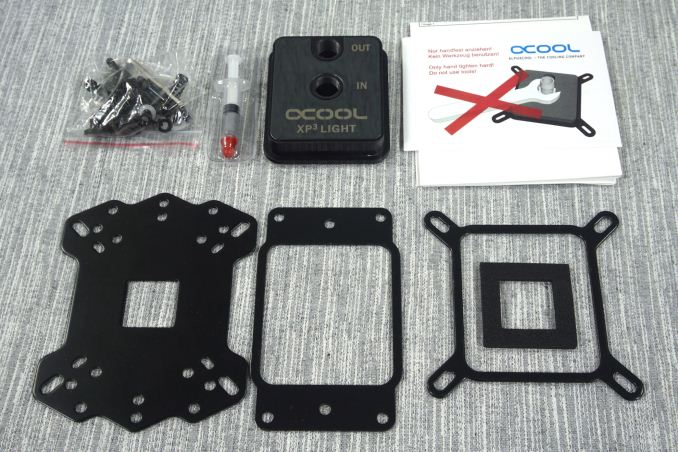
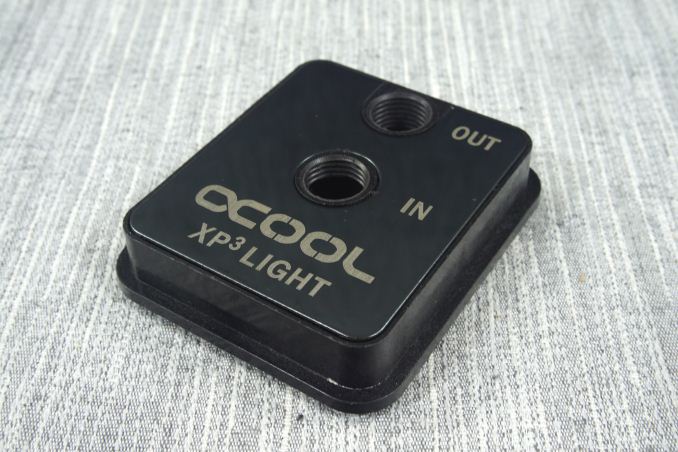
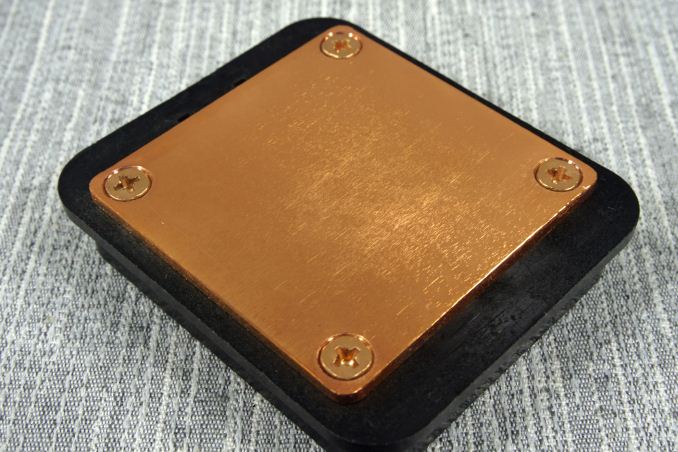
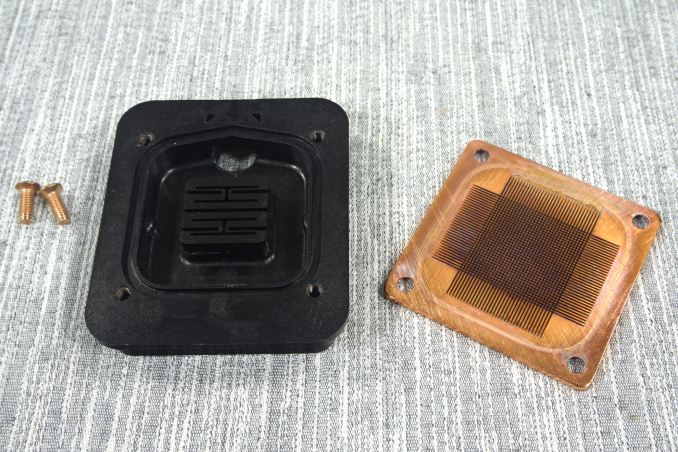
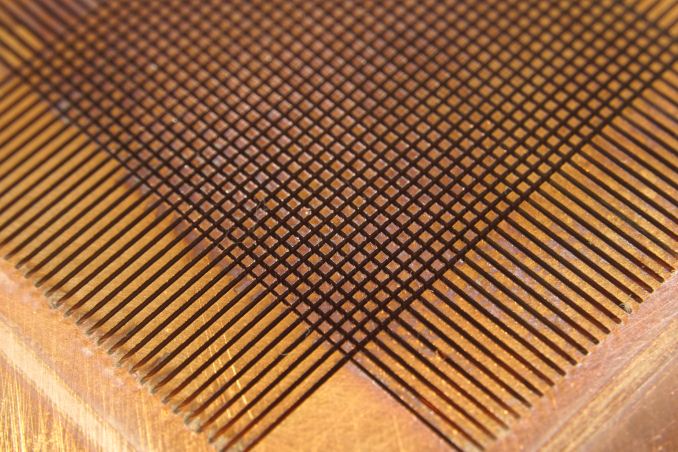
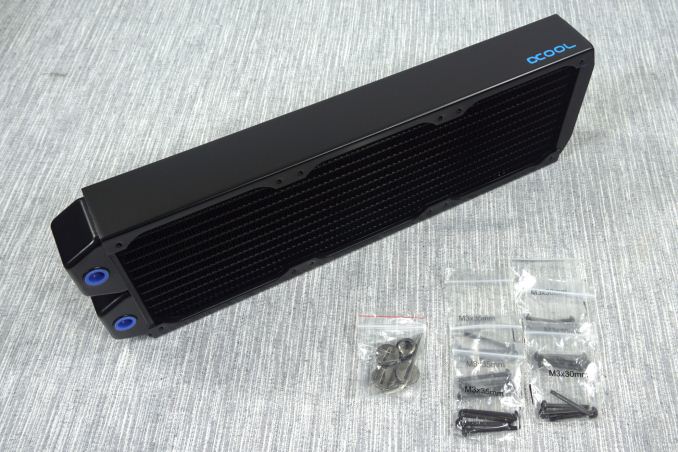
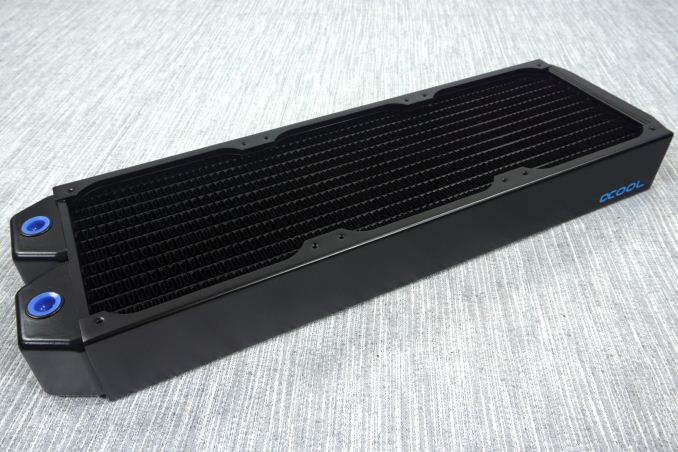
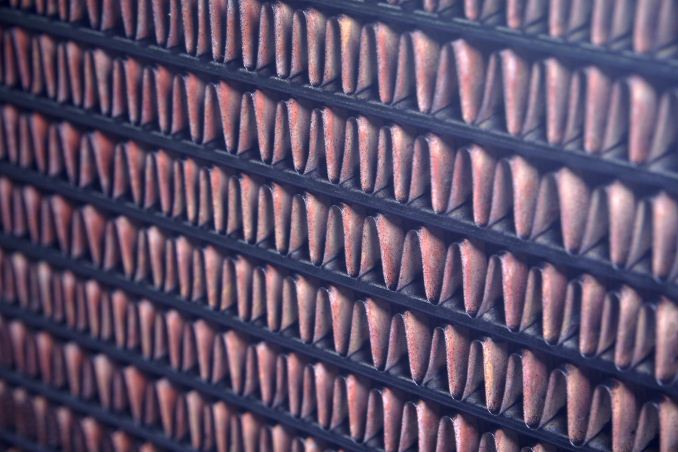
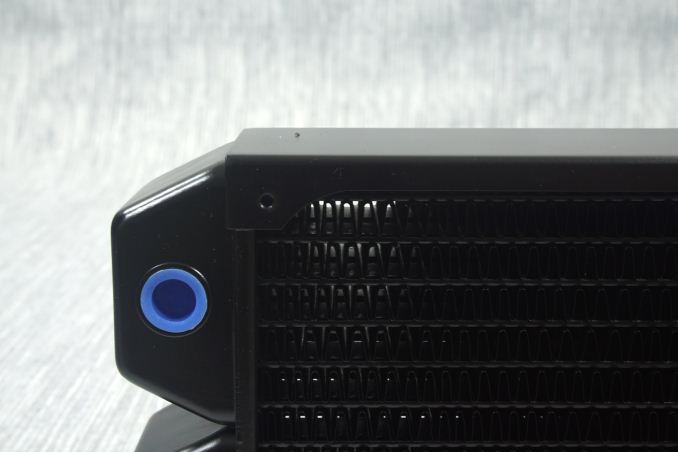









40 Comments
View All Comments
saratoga4 - Monday, October 24, 2016 - link
>copper block and a latheCopper block and mill. Lathe is the spinning one that works on pipes, mills are the drill type devices that cut blocks.
And yes, milling my first gpu cooling was pretty annoying. So much nicer these day :)
DanNeely - Monday, October 24, 2016 - link
Having used open loop coolers for the better part of a decade, I'll second that the DDC pump is going to be the loudest part if running at full speed unless you go crazy with fans. (I really wish someone would design a more suitable pump from the ground up instead of just slapping a modified top on the stock model.) However while it's picky about it's operating voltage you can slow and quiet them using PWM control. My current loop has a CPU, Mobo Mosfets, GPU, and a 560 radiator. Using an 4yo Swiftech DDC pump (not sure exact model they've got several of them) I've found that PWMing it to about 70% drops the high pitched pump noise below the noise floor of my low speed fans while only raising core temps by about 1-2C.Oxford Guy - Tuesday, November 8, 2016 - link
The pump in the EK L 2.0 kits is pretty quiet when suspended.Andrew LB - Wednesday, February 8, 2017 - link
I'm surprised they didn't use a pump like the DDC-1T PWM which is a 10w version that does 420l/h and is pretty much silent. I have one in my PC and even with an XSPC Raystorm V3 CPU block, Aquacomputer Krygraphics GTX 780ti full block, XSPC ex360 and ex280 radiators, and quite a few 90' and 45' XSPC rotary fittings, my DDC-1T PWM has a flow rate of 0.91gpm according to my Aquacomputer Aquaero with high-flow meter.Aerodrifting - Monday, October 24, 2016 - link
The part which the pump connects to the reservoir really concerns me. From the looks of it, It's just the barbs that come with DDC stock top (which we usually replace with custom ones to fit standard fittings plus better flow) go straight into the opening of the reservoir without any tightening measures. Are you sure that is not going to leak?BrokenCrayons - Monday, October 24, 2016 - link
The benchmark results are pretty impressive, but hardly worth the risk of mixing liquid with electricity or the added cost over just using the manufactuerer certified heatsink and fan that comes in the box with the CPU. So the processor runs at 40 degrees instead of 70. That's utterly meaningless to me when the max temp for a chip is typically +90 degrees and certainly not worth any additional cost at all much less a cost that includes the problem of pumping fluids around a system that works perfectly well with circulating air.Death666Angel - Monday, October 24, 2016 - link
It's a hobby. It can have some benefits, but it's a hobby first and foremost in my opinion. Yes, I could overclock my CPU and GPU some more while under water, it has a bit less noise and it can be more versatile. But modern aircooling is also pretty good, usually cheaper and not that much louder if you select good components. Though I will always spend a bit more to get a better cooler compared to the boxed offerings (headroom in the summer, dust buildup, better overclocking, quieter operations). But it depends on your setup and taste. :)BrokenCrayons - Monday, October 24, 2016 - link
That I can understand. Everyone has something they waste time and money on just for fun, but I don't think there's a practical reason behind it. I leave my desktop computer with it's 95W 860K CPU sitting in the mud room (no AC...basically my front porch) and run it headlessly to stream games. It spent the summer in ambient temps of around 80-85 degrees streaming games via Steam and the entire time it was and still is on the pre-Wraith HSF that came in the box with the CPU.Sure, I thought about replacing the cooler with something non-OEM or even getting a Wraith second hand from ebay or something, but there's absolutely no reason to do so. I can't rationalize spending even a minimal amount of money on it and then going through the trouble of opening the case up to replace the HSF. I might clean the dust bunnies out next spring, but at this point any additional cooling would serve no practical purpose.
letmepicyou - Monday, October 24, 2016 - link
There is a VERY practical purpose to water cooling which you're missing. If you've ever used a high end air cooler (and I have a cupboard full of them, up to the top shelf Thermalright Silver Arrow) then you know that they're HEAVY. This isn't a problem if your computer sits at your desk until cleaning time or your next upgrade cycle. I can promise you that having a huge cooler on your motherboard can be precarious if you tend to lug your PC around at all. You have to be pretty ginger with your movements.The reason I went to water cooling is now when I lug my PC around, I don't have to worry about component stresses. Given that I have a nice AIO loop on my CPU and run all SSDs, I could boot kick my tower and not worry about data loss or yanking the mounting post for my air cooler through the fiberglass of my motherboard.
BrokenCrayons - Tuesday, October 25, 2016 - link
Actually, my argument is in favor of OEM-boxed coolers that ship in retail packaging with the CPU. Those have never been too heavy for the mounting mechanisms that support them. The situation of an overweight air cooler is a self-inflicted wound that wouldn't have required the proverbial medical attention of liquid cooling had the person in question never picked up the overweight air cooler knife to begin with.